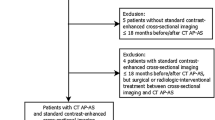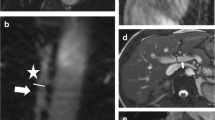Abstract
Background
The meso-Rex bypass restores blood flow to the liver in patients with extrahepatic portal vein thrombosis. Stenosis occurs in some cases, causing the reappearance of portal hypertension. Complications such as thrombocytopenia present on a spectrum and there are currently no guidelines regarding a threshold for endovascular intervention. While Doppler ultrasound (US) is common for routine evaluation, magnetic resonance (MR) angiography with two-dimensional phase-contrast MRI (2-D PC-MRI) may improve the assessment of meso-Rex bypass function.
Objectives
To determine the feasibility and utility of MR angiography with 2-D PC-MRI in evaluating children with meso-Rex bypass and to correlate meso-Rex bypass blood flow to markers of portal hypertension.
Materials and methods
MR angiography and 2-D PC-MRI in meso-Rex bypass patients were retrospectively analyzed. Minimum bypass diameter was measured on MR angiography and used to calculate cross-sectional area. Meso-Rex bypass blood flow was measured using 2-D PC-MRI and divided by ascending aortic flow to quantify bypass flow relative to systemic circulation. Platelet and white blood cell counts were recorded. Correlation was performed between minimum bypass area, blood flow and clinical data.
Results
Twenty-five children (median age: 9.5 years) with meso-Rex bypass underwent MR angiography and 2-D PC-MRI. The majority of patients were referred to imaging given clinical concern for complications. Eighteen of the 25 patients demonstrated >50% narrowing of the bypass cross-sectional area. The mean platelet count in 19 patients was 127 K/μL. There was a significant correlation between minimum cross-sectional bypass area and bypass flow (rho=0.469, P=0.018) and between bypass flow and platelet counts (r=0.525, P=0.021).
Conclusion
Two-dimensional PC-MRI can quantify meso-Rex bypass blood flow relative to total systemic flow. In a cohort of 25 children, bypass flow correlated to minimum bypass area and platelet count. Two-dimensional PC-MRI may be valuable alongside MR angiography to assess bypass integrity.







Similar content being viewed by others
References
Sharif K, McKiernan P, de Ville de Goyet J (2010) Mesoportal bypass for extrahepatic portal vein obstruction in children: close to a cure for most! J Pediatr Surg 45:272–276
de Ville de Goyet J, Alberti D, Clapuyt P et al (1998) Direct bypassing of extrahepatic portal venous obstruction in children: a new technique for combined hepatic portal revascularization and treatment of extrahepatic portal hypertension. J Pediatr Surg 33:597–601
Chaves IJ, Rigsby CK, Schoeneman SE et al (2012) Pre- and postoperative imaging and interventions for the meso-rex bypass in children and young adults. Pediatr Radiol 42:220–232
Lautz TB, Keys LA, Melvin JC et al (2013) Advantages of the meso-rex bypass compared with portosystemic shunts in the management of extrahepatic portal vein obstruction in children. J Am Coll Surg 216:83–89
Dasgupta R, Roberts E, Superina RA, Kim PC (2006) Effectiveness of rex shunt in the treatment of portal hypertension. J Pediatr Surg 41:108–112
Lautz TB, Kim ST, Donaldson JS, Superina RA (2012) Outcomes of percutaneous interventions for managing stenosis after meso-rex bypass for extrahepatic portal vein obstruction. J Vasc Interv Radiol 23:377–383
Parekh K, Markl M, Rose M et al (2017) 4D flow MR imaging of the portal venous system: a feasibility study in children. Eur Radiol 27:832–840
Rosenberg HK, Markowitz RI, Kolberg H et al (1991) Normal splenic size in infants and children: sonographic measurements. AJR Am J Roentgenol 157:119–121
Muthusami P, Yoo SJ, Chaturvedi R et al (2017) Splanchnic, thoracoabdominal, and cerebral blood flow volumes in healthy children and young adults in fasting and postprandial states: determining reference ranges by using phase-contrast MR imaging. Radiology 285:231–241
Eyraud D, Granger B, Ionescu C et al (2012) Thrombocytopenia, splenomegaly, and portal blood flow in patients who have undergone liver transplantation for cirrhosis. Liver Transpl 18:340–346
Huang TL, Chen TY, Tsang LL et al (2012) Hemodynamics of portal venous stenosis before and after treatment in pediatric liver transplantation: evaluation with Doppler ultrasound. Transplant Proc 44:481–483
Acknowledgements
A special thanks to 3-D analyst Brian Reilly from Ann & Robert H. Lurie Children’s Hospital of Chicago for his contribution of 3-D MR angiography reconstructions.
Author information
Authors and Affiliations
Corresponding author
Ethics declarations
Conflicts of interest
None
Electronic supplementary material
ESM 1
(PDF 52 kb)
Rights and permissions
About this article
Cite this article
Stefek, H.A., Rigsby, C.K., Berhane, H. et al. MR angiography and 2-D phase-contrast imaging for evaluation of meso-rex bypass function. Pediatr Radiol 49, 168–174 (2019). https://doi.org/10.1007/s00247-018-4284-8
Received:
Revised:
Accepted:
Published:
Issue Date:
DOI: https://doi.org/10.1007/s00247-018-4284-8




